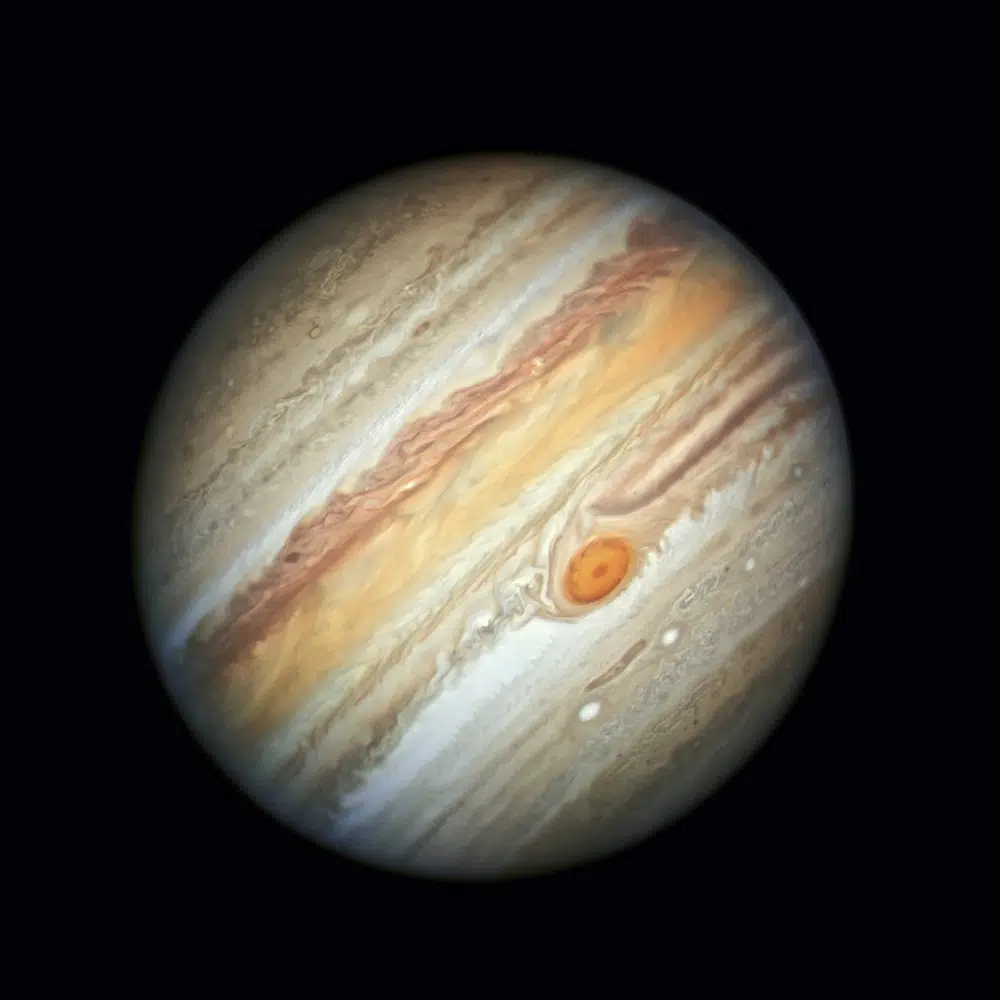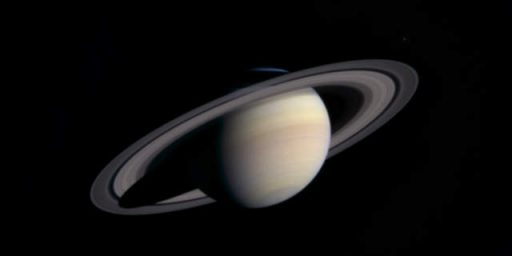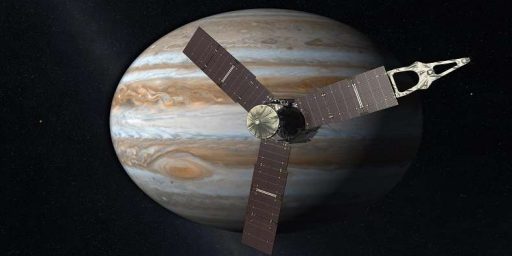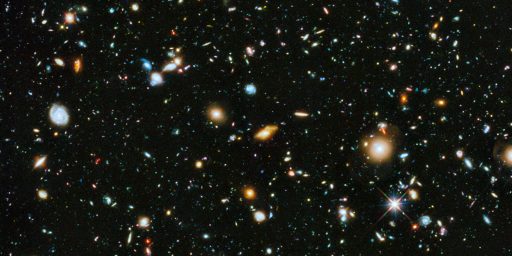Jupiter Keeps Adding Moons!
The science-education gap.

The Associated Press reports “Jupiter’s moon count jumps to 92, most in solar system.”
Astronomers have discovered 12 new moons around Jupiter, putting the total count at a record-breaking 92.
That’s more than any other planet in our solar system. Saturn, the one-time leader, comes in a close second with 83 confirmed moons.
The Jupiter moons were added recently to a list kept by the International Astronomical Union’s Minor Planet Center, said Scott Sheppard of the Carnegie Institution, who was part of the team.
They were discovered using telescopes in Hawaii and Chile in 2021 and 2022, and their orbits were confirmed with follow-up observations.
These newest moons range in size from 0.6 miles to 2 miles (1 kilometer to 3 kilometers), according to Sheppard.
“I hope we can image one of these outer moons close-up in the near future to better determine their origins,” he said in an email Friday.
In April, the European Space Agency is sending a spacecraft to Jupiter to study the planet and some of its biggest, icy moons. And next year, NASA will launch the Europa Clipper to explore Jupiter’s moon of the same name, which could harbor an ocean beneath its frozen crust.
Sheppard — who discovered a slew of moons around Saturn a few years ago and has taken part in 70 moon discoveries so far around Jupiter — expects to keep adding to the lunar tally of both gas giants.
If you had asked me to guess the number of moons around Jupiter—and, really, why would you?—I would have picked a number way less than 92. At the end of the day, it’s not something that I’m called upon to know and, for whatever reason, isn’t something that I keep up with.
Like presumably all Americans, I had a unit on the Solar System in early elementary school—probably 2nd or 3rd grade. I vaguely remember building a diorama of the planets and their relationships to one another and learning some odd facts about them. This would have been roughly 1973 or 1974—so half a century ago.
Astronomers have made tons of discoveries since then but they’re not widely reported and often don’t update my understanding. The only two exceptions that come immediately to mind were the 1979 discovery by Voyager 1 that Jupiter had rings—which I think I learned about from a sitcom!—that created serious dissonance because having rings was Saturn’s distinguishing feature and the 2006 announcement that Pluto was no longer a planet. That happened during OTB’s history so I blogged about that multiple times starting in August 2005 when the question bubbled into public consciousness.
While I’m sure there are better resources out there, Wikipedia‘s “Timeline of discovery of Solar System planets and their moons” does a solid job of summarizing the flow of human knowledge of the topic. What’s really remarkable is how much we knew prehistorically—7 of the 8/9 planets were discovered well before the invention of the telescope (which I’m sure I knew once upon a time but had faded through lack of retrieval).
Of more direct interest, though, is just how much we’ve learned since I was in school. Or, more to the point, the amount scientists have learned that I have not. It turns out that, when I made my diorama, Saturn’s 11th and Jupiter’s 12th (and possibly 13th) moons had been “discovered.” (The 13th, Leda, was discovered in September 1974 and I just can’t recall when I learned this.)
Three Jupiter moons and Pluto’s first moon were discovered during the remainder of the 1970s.
We had an explosion of moon discoveries in the 1980s from Voyager 1 and 2: eight more around Saturn moons, 10 around Uranus, 2 around Jupiter, and one around Neptune.
In the 2000’s we named 41 more around Jupiter alone! And Saturn didn’t do so bad herself, gaining 36. And that’s not counting the unnamed ones.
The charts get incredibly messy after that but we’re finding these moons–many of them really small—in droves now.
It’s simultaneously fascinating and amusing. The latter because there are things that we learn about as kids and tend not to update much as we grow up. The best other example that comes to mind is dinosaurs. Pretty much all of the dinosaur names that I learned in school —probably around the same time I learned the solar system!—-changed years ago. (Indeed, they were changing in scientific circles already when I learned them, but it would take decades for it to influence common usage.)





Better headline: “Jupiter Keeps Mooning Us”
Thanks. I’ll be here all week.
Seriously though, thanks for the non-political story. It’s good to have the occasional break.
When the moon is in the seventh house,
And Jupiter aligns with Mars…
I’ll show myself out.
Many of the moons in the Solar System are captured asteroids or comets. Perhaps these can be redefined in much the same way Pluto was, just to keep the numbers down to manageable levels.
The actual term, BTW, is satellite rather than moon. Moon is the proper name of the Moon. Calling the natural satellites of other planets moons, is like calling other planets earths. “Jupiter is the Solar System’s earth with the most moons,” sounds just stupid.
But this complicates my suggestion. A satellite is any body that orbits a larger body. So any small stray tock orbiting Jupiter is as much a satellite as Ganymede or Europa. But so is every speck of stray dust captured by passing through a comet’s path, and even every stray atom or molecule. Count every last fragment in Saturn’s rings now 😉
So maybe we shouldn’t lock on to definitions that are too vague, and thus stop making a big deal about every newly discovered pebble found to orbit a giant planet.
Now, if we found a new large satellite orbiting Jupiter or Neptune, that would really be something. But that’s as likely as finding a new surface continent on Earth, or a spine in a Republiqan politician.
@Kathy: Yes, I gather that we don’t have firm upper or lower size limits. Still, even the smaller of Jupiter’s “moons” are a kilometer in diameter. Small, but hardly “pebbles.”
@MarkedMan: At least it’s not Uranus.
@Kathy: I dunno, a long time ago in a galaxy far, far away they used the term “moon.” 😉
@Kathy:
I suspect actual usage has caused that ship to sail.
@Steven L. Taylor: There you go
I wish more people knew about Eris, after which Pluto’s demotion makes more sense:
Eris is a TNO that is more massive than Pluto, and after it was discovered it was hard to argue that if Pluto is a planet that Eris is not also a planet, and there was a concern we could end up with a situation where there’s dozens or hundreds of “planets” hanging around out there.
If Galileo didn’t see it, it is not a moon of Jupiter. Those other things are Jupiter Orbiting Boulders and Satellites or JOBS. Under Biden we have added a lot of JOBS; haven’t you seen the headlines?
@Stormy Dragon:
Especially given that Eris’ revolves in another 2:3 resonance with Neptune, just like Pluto. The same orbital period, just on another direction from Neptune.
@James Joyner:
By mass, the planets are made up of Jupiter and debris.
This is dwarfed by the Solar System, which is made up, by mass, of the Sun and debris.
Also, I love the fact that earth has a freakishly huge moon compared to the other planets that have them (it is suspected this is because earth’s moon was the result of collision with an object about the size of Mars rather than the normal way moons form)
Well Jupiter is basically the vacuum for our solar system.
@Stormy Dragon: I also love that our Moon is freakishly large. If it were small, then it would not skim off some atmospheric gases, and Earth would be a lot like Venus, hard for DNA life forms.
I had a strange astronomy-related dream a few weeks ago. It happened when I fell asleep shortly after reading an article from a science magazine on the early history of the solar system. Also, a couple of weeks earlier I’d watched a documentary about an astronaut. Also, I was recently visiting Long Island, where I used an app I’d downloaded that enables you to identify astronomical objects in the night’s sky. I was able to identify three planets (including Jupiter), but no stars. (This is better than in Manhattan, where I live, where you can’t see shit.)
So, in this dream, I was on a tour of Pluto. Sometimes I thought we were in a museum about Pluto, other times I thought we were actually on Pluto. No explanation was given for how we got there, how we were supposed to get back, or how we were all breathing and walking around normally, without oxygen tanks. The way the sky looked on Pluto ranged from the way the night sky normally looks on Earth to a twilight look. At one point, we looked into the sky and saw what looked like the way Jupiter had appeared to me on Long Island, but we were told that this was actually the sun, because Pluto was so far away from the sun that it would appear as practically a dot in the sky. (This was perhaps the only aspect of the dream that was scientifically accurate.) I momentarily worried that looking straight at the sun might damage my eyes.
Oh, and I almost forgot: Harrison Ford was in a space suit floating through space, and when he saw Pluto, he simply said, “Thermal.” The tour guide told us people were still trying to figure out what he meant when he said that.
@Kylopod:
The AI du jour gives a contradictory answer to the question “is the sun too bright to look at from pluto?” Here it is:
TL;DR It’s not too bright to look at, but don’t look at it because it can cause permanent eye damage.
Clear?
The BBC’s Science Focus magazine gives a more cogent answer:
You probably should not look directly at the Sun while on Pluto without some sort of filter, like those rated for partial and annular solar eclipses on Earth.
@Kathy:
Thank you. I will make sure to heed this advice the next time I am on Pluto, and relay that info to whoever I am with. 😉
Why remarkable? If you look up and pay attention, there they are!
@Sparky: But, to the naked eye, they appear to be stars. That people plotted their patterns and figured out that they were a whole different class of objects with so little visual input is remarkable to me.